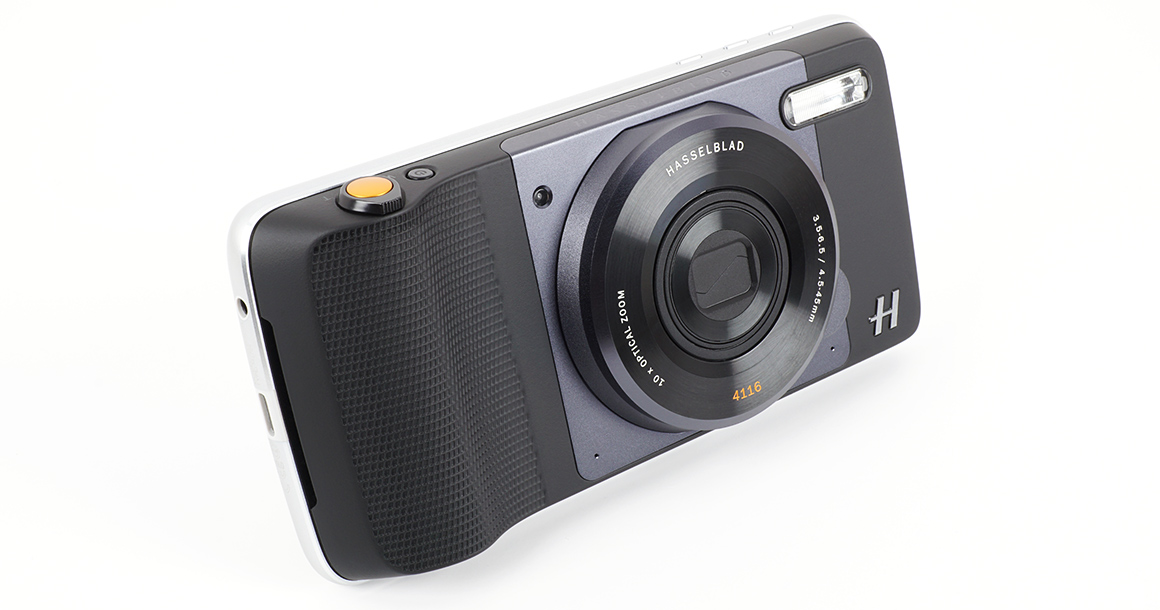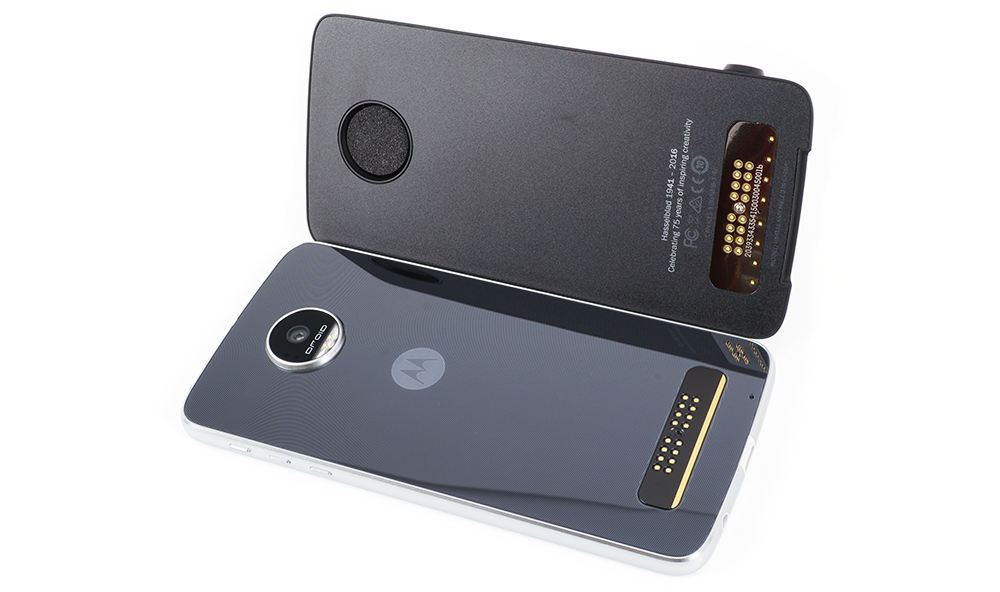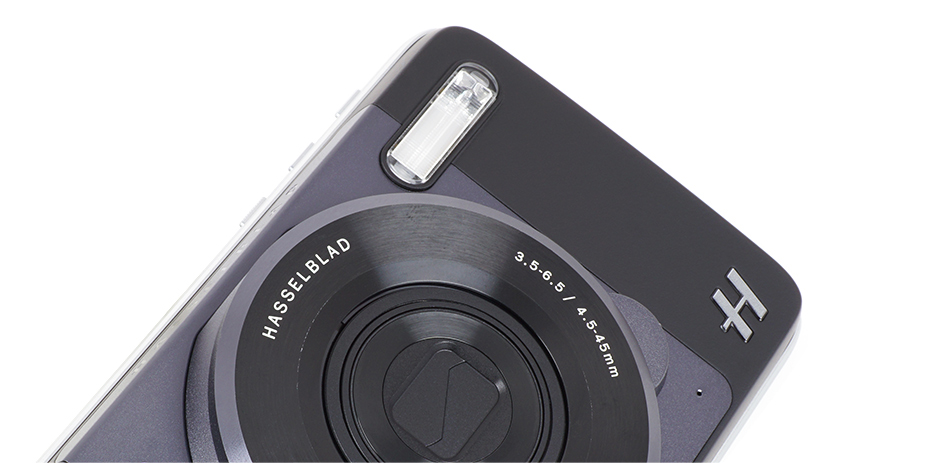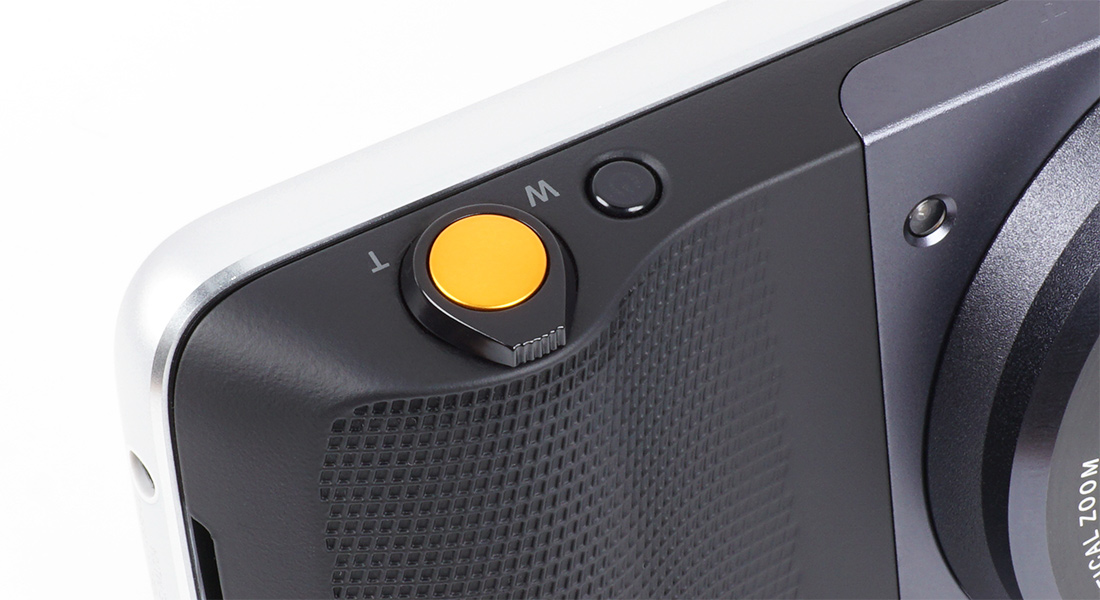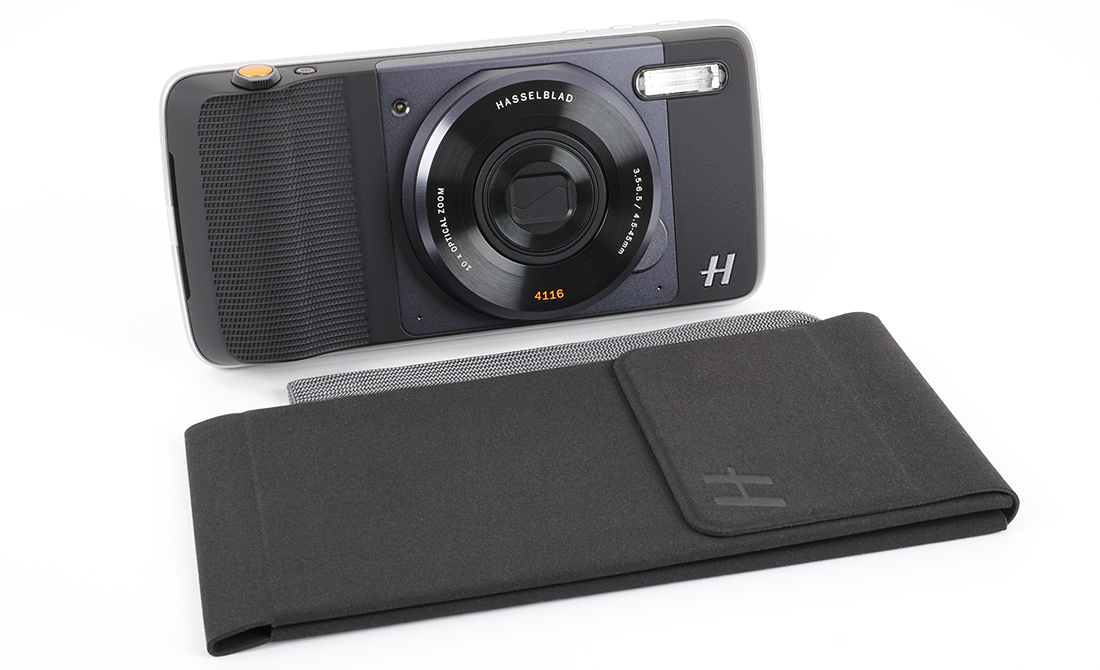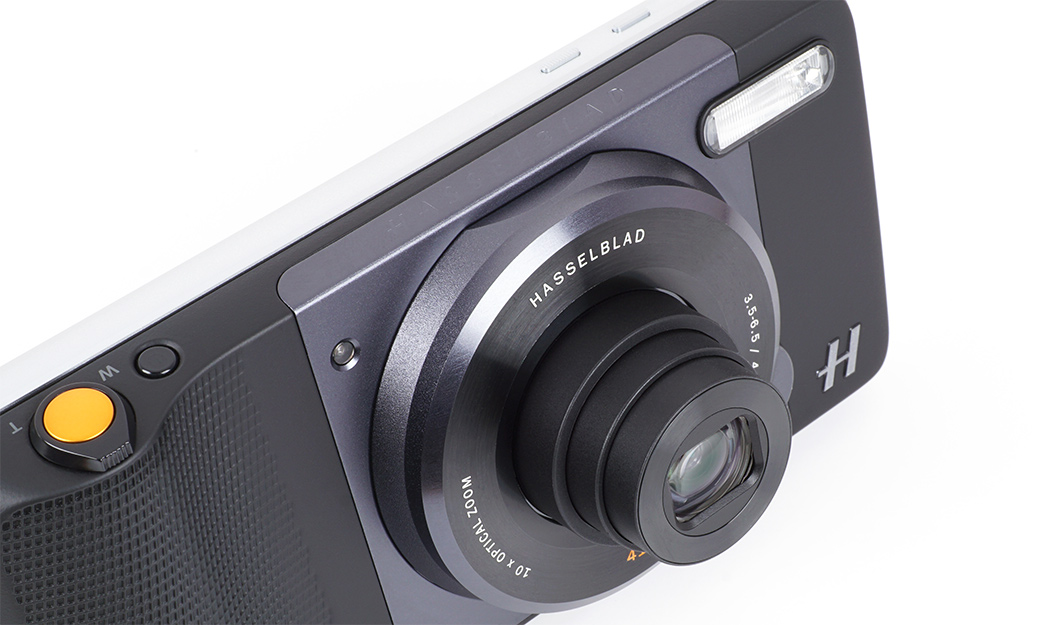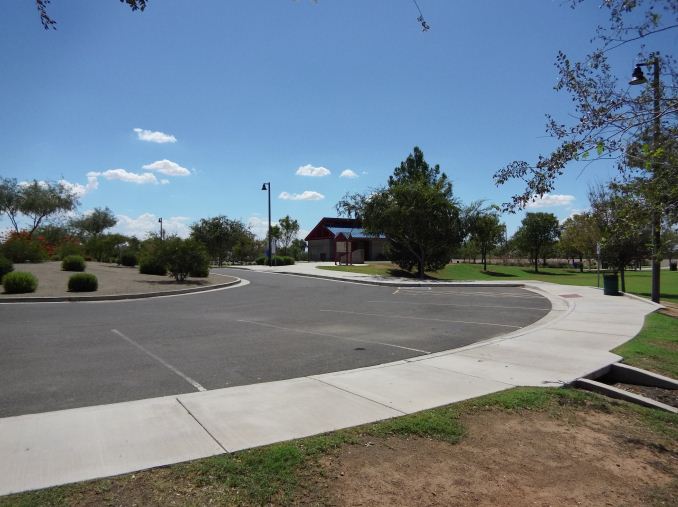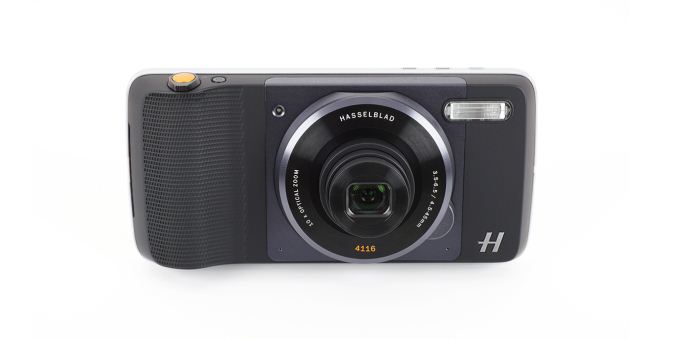
Lenovo-owned Motorola went in a completely different direction for its flagship phones this year. The revamped Moto Z family’s styling eschews tradition and higher prices with better-performing hardware push the Moto Z Droid and Moto Z Force Droid further into flagship territory than previous models (the Moto Z Play Droid falls into the midrange category). The biggest change, however, is Motorola’s move to modularity. We’ve been hearing promises of modular smartphones for a while, but it only became a reality this year—first with LG’s G5 and then the Moto Zs.
Modules allow us to add specialized or situation specific capabilities to our phones such as a larger battery when traveling, additional sensors for monitoring your health, or a more-powerful speaker for listening to music with friends. And by splitting off hardware into separate modules, the base cost of the phone can be reduced, freeing us from paying for features we do not use—at least in theory.
Motorola’s Moto Mod platform is well executed, but I’m still not sold on the modular concept. What makes smartphones so powerful and portable are tight hardware integration and the ability to wirelessly connect to other devices and networks. Splitting hardware off into a separate module with its own packaging considerations or attaching what’s normally an external accessory, such as a Bluetooth speaker, onto the phone negates both of these advantages, resulting in something that’s bigger, heavier, and possibly more expensive. It does not help that the existing Moto Mods—the JBL SoundBoost speaker and the Moto Insta-Share projector—are not particularly compelling either, although the Power Packs are useful for increasing battery life.
So why does the Hasselblad True Zoom Mod exist? What problem does it solve? Why should you pay extra money for a camera module that covers up the phone’s integrated rear camera that you already paid for? Well, like LG’s CAM Plus module for the G5, the Hasselblad True Zoom Mod provides a traditional grip that transforms the look and feel of the phone into something similar to a point-and-shoot camera. It also adds physical controls for basic camera functions, making it easier to use, especially one-handed, which is actually possible thanks to the aforementioned camera grip.
These ergonomic improvements are certainly welcome—snapping a picture with a large, slippery phone can be tricky—but this module’s raison d’être is 10x optical zoom. With the exception of a few specialty phones, such as the ASUS ZenFone Zoom (3x optical), smartphone cameras come with fixed lenses, a necessary concession to keep chassis thin and costs down. Without the ability to change focal length, smartphone cameras can only offer digital zoom, which is merely an illusion achieved by cropping the image and applying some post-processing to clean up the image a bit. This significantly degrades image quality by effectively reducing the final image’s resolution. Optical zoom, however, maintains detail and sharpness by physically moving the lens, thereby changing the focal length and magnifying the scene. In the case of the Hasselblad True Zoom Mod, the improvement is quite dramatic.
Unlike LG’s CAM Plus, which just adds a grip, physical controls, and a larger battery to the G5’s existing rear camera, the Hasselblad True Zoom Mod is a complete camera replacement. In addition to the Moto Mod connector’s exposed gold pins, the back of the True Zoom has a foam-cushioned circular recess that fits over and protects the Moto Z’s raised camera module, which also helps keep the True Zoom from sliding off. The True Zoom easily attaches to the back of the phone with strong magnets. The connection is quite secure, so it’s good that there’s a recess on one end to get a finger under for prying it off.
One of the advantages of the Moto Mod system is that the modules are hot-swappable and do not require rebooting the phone or messing with settings. Once the True Zoom snaps into place, the phone makes an audible alert and a small vibration confirming it’s attached. Motorola’s camera app includes a few options specific to the True Zoom, such as special modes for sports, portraits, and landscape shots, but the camera works with third-party apps too just like the Moto Z’s integrated camera.
The front of the True Zoom looks just like a point-and-shoot camera with a zoom lens that extends from a raised plastic ring. The lens retracts into the body and sits flush with the ring when the camera is powered off and a plastic door closes to protect the lens. The motor that operates the lens makes an audible noise, but it’s not loud enough to bother me. Just below and to either side of the raised ring are two microphones, and there’s an orange focus assist LED above, which definitely helps AF performance in low-light conditions. There’s also a bright Xenon flash in the upper corner that’s similar to what’s found on small cameras.
The plastic module has a textured grip on the right side (sorry lefties) with a rubberized coating that extends around the edges and most of the front that makes it pretty easy to hold, although the grip is undersized for larger hands. There’s a physical shutter button on the top that can be pressed halfway for exposure and focus lock. This button is surrounded by a plastic dial for controlling the zoom level, which is the only part of the module that feels cheap and flimsy. Next to the shutter button is a small power button that wakes the phone, opens the camera app, and turns on the camera, extending the lens when pressed. Pressing it again turns off the camera, closes the camera app, and leaves you at the home screen rather than turning off the phone too. Opening or closing the camera app also turns the True Zoom on and off automatically, so you do not always need to use the button.
The True Zoom is between 9mm and 15mm thick. Snapping it onto the Moto Z Play Droid or Moto Z Force Droid brings the total thickness to 16mm/22mm or a slightly slimmer 14.2mm/20.2mm on the Moto Z Droid. This is in the same range as dedicated compact cameras with zoom lenses and 1/2.3” format sensors, so there’s no thickness penalty associated with using the True Zoom module. It’s still compact enough to slide into a pocket or the soft-touch carrying case with magnetic flap that comes with the True Zoom.
Because the smartphones the True Zoom attaches to carry a larger battery and a lot more hardware inside than a compact camera, there is a size and weight penalty for the modular approach. The True Zoom weighs in at 145 grams, which is right around the average weight for comparable compact camera; however, once it’s attached to one of the Moto Zs, the total package weight increases to 281-310 grams, about twice as much as a dedicated camera. This weight is still manageable, but you’re going to feel it sitting your pocket.
Keeping the True Zoom attached also compromises the smartphone experience. There’s the obvious issue of the phone being noticeably heavier—the arm gets tired quickly holding the phone to an ear—and the raised ring around the camera is less comfortable in the palm of your hand than the usual smooth, curved back of a phone. For short stints it’s not a big deal, but if the camera will not be used for a while, it’s best to pop it off and put it away.
The Hasselblad True Zoom Mod both looks and functions like a compact camera. The tradeoffs for a modular design are manageable considering the additional features it provides. It has an attractive design, and is well integrated with the Moto Z’s software, making it feel like it belongs on the phone rather than a piece slapped on the back.
If you were hoping for an upgrade to a larger format sensor, you’ll be disappointed. The Hasselblad True Zoom Mod still uses a 1/2.3” CMOS sensor. This is a large sensor for a smartphone but a smartphone sensor nonetheless, with specifications similar to the HTC 10’s rear camera. Moving to a larger sensor would require increases in thickness and cost, so this is not necessarily a bad choice. Based on its size and features, the True Zoom’s main competition is point-and-shoot compact cameras like Canon’s PowerShot or Sony’s Cyber-shot lineups that also use 1/2.3” sensors in cameras that cost up to $ 450, which is the entry price for a camera with a larger 1” or APS-C format sensor, so it’s not like the True Zoom is at a disadvantage here.
The True Zoom’s 12MP backside-illuminated CMOS sensor uses 1.55µm pixels and captures images with a 4:3 aspect ratio at its native resolution. We cannot pin down the source for the sensor, however. Both Sony and OmniVision make sensors that fit this description and Motorola has sourced parts from both before.
| Moto Z Rear Camera Details | ||||
| Hasselblad True Zoom | Moto Z Play Droid | Moto Z Droid | Moto Z Force Droid | |
| Resolution: Photo | 12MP | 16MP | 13MP | 21MP |
| Resolution: Video | 1080p30 | 1080p30, 4K30 | 1080p60, 4K30 | 1080p60, 4K30 |
| Sensor | ? (1.55µm, 1/2.3″) |
OmniVision OV16860 (1.3µm, 1/2.4″) |
Sony IMX214 Exmor RS (1.12µm, 1/3.06″) |
Sony IMX338 Exmor RS (1.12µm, 1/2.4″) |
| Focal Length | 4.50-45.00mm (25-250mm equivalent) | 4.68mm (27mm equivalent) | 3.68 (27mm equivalent) | 4.51mm (26mm equivalent) |
| Zoom | 10x optical 4x digital |
8x digital | 8x digital | 8x digital |
| Aperture | f/3.5-6.5 | f/2.0 | f/1.8 | f/1.8 |
| Image Stabilization | OIS / EIS | EIS | OIS / EIS | OIS / EIS |
| Autofocus | PDAF/Contrast | PDAF/Laser/Contrast | Laser/Contrast | PDAF/Laser/Contrast |
| Flash | Xenon | dual-color LED | dual-color LED | dual-color LED |
| Dimensions | 152.3 x 72.9 x 9.00-15.10 mm 145 grams |
156.4 x 76.4 x 6.99 mm 165 grams |
153.3 x 75.3 x 5.19 mm 136 grams |
155.9 x 75.8 x 6.99 mm 163 grams |
| Launch Price (No Contract) | $ 250 (Verizon) / $ 300 (Moto) | $ 408 | $ 624 / $ 674 | $ 720 / $ 770 |
The True Zoom includes optical image stabilization (OIS) for still photos and electronic image stabilization (EIS) for videos. It also uses a combination of phase detect autofocus (PDAF) and standard contrast autofocus. Laser autofocus is not included but the focus assist LED fills a similar role, improving focus performance in low-light conditions over short distances.
The 10x optical zoom lens has a variable 35mm equivalent focal length of 25-250mm with an aperture that varies from f/3.5-6.5. This gives the True Zoom an aperture area smaller than any smartphone camera we’ve tested at 1x zoom; the HTC 10, which also has a 1/2.3” sensor and 1.55µm pixels, has an aperture area that’s nearly 4x larger. This is a byproduct of using a variable aperture zoom lens, which tend to be slower than fixed aperture prime lenses, to reduce cost and weight. We’ll see what effect this has on low-light performance in the next section.
The True Zoom will record video, of course, but unless you specifically need to shoot video of something at a distance, you’re better off using the phone’s camera. For starters, it will not record 1080p60 video like the Moto Z or Moto Z Force nor will it record 4K video like all three Moto Zs can. It does record 1080p video at an average bit rate and using the high profile, but only at 24fps. I do not think I’ve reviewed a phone that could not do 1080p at 30fps, assuming it could record 1080p at all. I’m not sure if this is a bandwidth limitation from the Moto Mod connector or a cost saving measure, but the camera sensor is more than capable of recording up to 4K at 30fps.
| Hasselblad True Zoom Mod: Video Modes | ||
| Video Mode | Video | Audio |
| FHD 1080p | 1920×1080, 17 Mb/s, H.264 High | 128 Kb/s, 48 KHz AAC |
| HD 720p | 1280×720, 10 Mb/s, H.264 High | 128 Kb/s, 48 KHz AAC |
| VGA 480p | 640×480, 6 Mb/s, H.264 Baseline | 128 Kb/s, 48 KHz AAC |
Between the lack of recording options and the choppy looking 24fps video, it’s best to pop off the True Zoom and use the phone’s camera if the subject of the video is reasonably close, which is not ideal. However, its optical zoom makes the inconvenience of carrying around the True Zoom and taking it on and off justifiable. It allows you to take videos of things that just are not feasible with a regular smartphone camera because they’re too far away.
Video quality is pretty good overall. White balance, exposure, and noise are similar to video taken with the Moto Zs. The less than fluid 24fps 1080p video (both the 720p and 480p modes record at 30fps) and lack of HDR are the biggest negatives. The True Zoom’s electronic image stabilization works wonderfully, though, completely eliminating hand shake. This is especially important for a zoom lens because the large distance between camera and subject can turn even the smallest movements at the camera into large shifts in the captured image. Even at 10x zoom, however, the True Zoom’s video remains steady, deftly soaking up small vibrations from your hands.
In the video sample above, motor noise while zooming is clearly audible. And by clearly audible, I mean it’s very loud. Another issue is that the zoom speed is not variable and not very precise. It’s more of an on/off button, so you will not be able to do any slow, cinematic zooms or zoom precisely to a specific point. For these reasons, it’s better to select the desired zoom level before recording or edit out the periods while zooming.
Because the Hasselblad True Zoom Mod covers up the Moto Z’s rear camera when attached, it’s only natural to wonder if it actually provides a boost to image quality. To help answer this question, we’ll be comparing pictures taken with the True Zoom in various lighting conditions to those from all three Moto Zs (Moto Z Play Droid, Moto Z Droid, Moto Z Force Droid) along with the LG G5 and Galaxy S7, which have some nice cameras.
| Daylight Photo Comparison 1 |
Right out of the gate the True Zoom produces the worst image of the group. Its white balance is good and it avoids overexposing and clipping the white clouds like all three Moto Zs, but it has significantly more noise in the sky than all the other phones—visible even when zoomed out—and it shows less detail. The corners and edges of its image look particularly soft.
The Moto Z Play, despite being the entry level Z, captures a better image than the Moto Z and its older Sony IMX214 sensor. The Moto Z Play still overexposes its image like the Moto Z Force, but it does a good job setting the white balance and captures a lot of fine detail.
| Daylight Photo Comparison 2 |
Most of the cameras do well setting exposure and white balance in our second daylight scene, where I kept HDR disabled even though there’s an equal mixture of brightly lit and shadowed areas. The Moto Z and Moto Z Force capture brighter images, but clip the bright reflection on top of the umbrella. The Moto Z’s white balance is just a hint warm, while the Moto Z Force’s image is just a tad yellow, although these are not major issues. Once again the True Zoom gets the exposure and white balance correct.
The Moto Z Force, Moto Z Play, and Galaxy S7 all capture a lot of fine detail, although the latter’s 12MP sensor runs out of resolution when trying to resolve the text on the signs and texture on the building in the far background. The detail the S7 captures is very sharp, however. With heavier noise reduction processing, object edges in the G5’s and Moto Z Force’s images look just a little blurrier. The Moto Z Play’s image sharpness is just a step behind the Force’s, but still significantly better than the more expensive Moto Z’s, whose aggressive noise reduction processing smears away texture on the gray wall along with everything else in the picture. The True Zoom does a little better than the Moto Z, but is still noticeably worse than the Moto Z Play.
While noise is not an issue for either the G5 or S7 in this scene, all three Moto Zs do a little better job smoothing away noise grain. This is not the case with the True Zoom, which, once again, shows significantly more noise than the other cameras in this roundup, to the point that it becomes visibly distracting. There’s also some purple fringing along a few edges in its image that appear to be byproducts of post-processing.
The Moto Z Play, despite being the entry level Z, captures a better image than the Moto Z and its older Sony IMX214 sensor. The Moto Z Play still overexposes its image like the Moto Z Force, but it does a good job setting the white balance and captures a lot of fine detail.
| Zoom Comparison 1 |
The True Zoom’s headlining feature of course is its 10x optical zoom. Zooming in on the park across this field, the True Zoom just blows the other cameras away. There’s a lot of detail visible in the trees and grass, and it’s even possible to count how many lines of text there are on the white sign to the right of the orange slide. There’s a little bit of noise and edge fuzziness, but it’s certainly a useable image.
This is in stark contrast to the digital zoom used by the other cameras and their fixed focal length lenses. Digital zoom involves cropping and blowing up the original, non-zoomed image, resulting in a substantial loss of resolution, coupled with some post-processing to try and enhance the mess this creates. The LG G5 does pretty well, considering, producing an image that still shows some detail. The Moto Z clearly does the worst; I mean you can tell it’s a picture of a park if you look closely, but I would not consider it a useable picture.
| Zoom Comparison 2 |
In this second example, the LG G5 and Galaxy S7 produce acceptable images using their digital zoom features, clearly showing the individual bricks on the building but not able to resolve their texture. Likewise, it’s possible to see which areas of text and images on the sign out front, but it’s impossible to read the text or see what the pictures show. All three Moto Zs show even less detail, and there’s very obvious white halos around the building and trees from edge sharpening; apparently Motorola’s unsharp mask filter does not scale with zoom level, resulting in very wide, light-colored bands around dark objects.
The True Zoom’s image is actually quite impressive. We can actually see some texture on the bricks and the hatch pattern on the green trash receptacle. Even the photos and some of the text on the sign are visible! This photo basically explains why this product exists.
| Low-Light Comparison |
It’s difficult to pick a winner in this dark scene lit by a single yellow sodium lamp, because each camera falls short in at least one area. The LG G5, Moto Z Play, and Galaxy S7 capture the brightest images, while the True Zoom’s is the darkest of the group. It also sets white balance too warm, a problem shared with the Moto Z, G5, and S7. The image with the most accurate colors belongs to the Moto Z Play.
Looking closely at the rocks and bushes, it’s clear the S7 and Moto Z Force capture the most detail. The rocks in the True Zoom’s picture also show quite a bit of detail, but its noise reduction processing produces some yellow splotches. The Moto Z Play had difficulty focusing, resulting in a blurred image, and the Moto Z’s aggressive noise reduction leaves the rocks and bushes looking unnatural. The G5’s noise reduction processing performs poorly here, simultaneously smearing away a significant amount of detail while leaving behind the most visible noise grain.
The Hasselblad True Zoom Mod’s main competition is small point-and-shoot cameras, which is reflected in its design, features, and price. It certainly looks like a camera, and when it’s attached to any of the Moto Zs, the total package is about the same thickness as a standalone camera. The downside to the modular approach, however, is weight. With about twice the heft of a typical point-and-shoot, it’s far less pointy. Fortunately, the rubberized coating and raised, textured grip make it easy to hang on to with one hand. Its dual-stage shutter button works well, but the plastic zoom dial feels a bit cheap and works like an on/off switch, making it difficult to zoom smoothly or select an intermediate zoom value.
Having a true 10x optical zoom, brighter flash, and AF assist light all extend the capabilities of the typical smartphone camera experience. Its 1/2.3″ format sensor is common in point-and-shoots and even in some smartphones, though, and for this reason, the True Zoom’s image quality is not any better than what’s attainable with a flagship phone. The cameras in the Moto Z Force and Moto Z Play produce better images in all lighting conditions, and while the True Zoom captures more detail than the Moto Z, its images are noisier.
The True Zoom’s video recording capabilities are not as robust as the Moto Zs’ native cameras either. It only supports up to 1080p24, which makes scenes with any motion or panning look rather choppy. The lens’ zoom motor makes a fair bit of noise too, which comes through loud and clear in the recorded video. The True Zoom does have very good electronic image stabilization, though.
Based on its performance and weight, the True Zoom is not a camera replacement that would be left attached all the time, but rather a tool that augments the existing cameras in the Moto Zs in situations that require the use of its headline feature: 10x optical zoom. Not only can it magnify objects at a pretty significant distance, but its image quality at maximum zoom is phenomenal compared to the blurry mess that comes from using a smartphone’s next-to-useless digital zoom.
The True Zoom costs $ 300 directly from Motorola or $ 250 from Verizon, which is about the same price as a standalone point-and-shoot. If the True Zoom delivered better performance than the Moto Zs’ built-in cameras at all zoom levels and in all lighting conditions, it could be a worthwhile upgrade. It does not, however, which makes it specialized tool that’s best used for taking good pictures of objects more than about 20 feet away.
Autore: AnandTech

